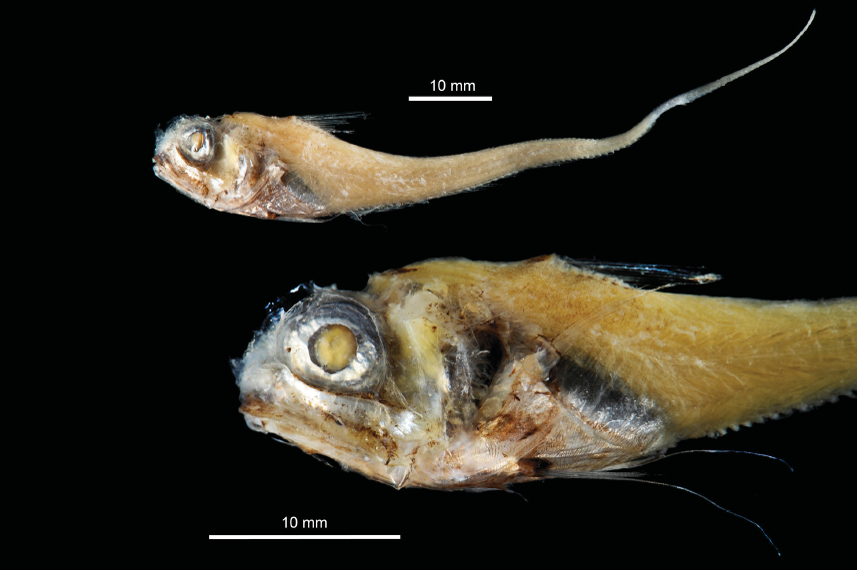Iwamoto's Whiptail, Hymenocephalus iwamotoi Schwarzhans 2014

Hymenocephalus iwamotoi - holotype (above) and paratype (below), from off Browse Island, Western Australia. Source: M. Krag / Schwarzhans 2014 Zootaxa 3888. License: CC by Attribution
Summary:
A small grenadier with a short, blunt, not depressed snout, head with soft non-spatulate nose flaps and an extensive cephalic canal system with a thin integument cover, a large eye, a broad interorbital space, a long barbel reaching to below the rear of the eye, and no denticles on the first dorsal-fin spine.
Silvery bioluminescent striae extends along both sides below the gill covers, reaching the pectoral-fin bases and behind the pelvic-fin bases, and along the ventral midline almost to the periproct region around the anus. The posterior lens of the light organ is rounded.
Silvery bioluminescent striae extends along both sides below the gill covers, reaching the pectoral-fin bases and behind the pelvic-fin bases, and along the ventral midline almost to the periproct region around the anus. The posterior lens of the light organ is rounded.
Cite this page as:
Bray, D.J. 2017, Hymenocephalus iwamotoi in Fishes of Australia, accessed 01 Jul 2025, https://fishesofaustralia.net.au/home/species/5133
Iwamoto's Whiptail, Hymenocephalus iwamotoi Schwarzhans 2014
More Info
|
Distribution |
Off northwestern Australia, in the vicinity of Browse Island, WA, 13°47’S, 123°18’E, 242 m. |
|
Features |
Pelvic fin 7-9; Pectoral fin 12–13; First dorsal fin II + 6–7; Gill rakers 17–20. Barbel long 40–46% HL, reaching vertical through rear end of orbit. Orbit 35–38% HL. Snout rounded, barely protruding, short 15–19% HL. Posterior luminescent lens round; ventral striae extending to near periproct. Silvery bioluminescent striae extends as a narrow band along both sides below the gill covers, reaching up to the pectoral-fin bases and behind the pelvic-fin bases, then join along the ventral midline andexpands almost to the periproct region around the anus. Some dark striae is also present on the gular region. The anterior lens of the ventral luminescent organ is small and pale. The rounded posterior lens before the periproct is about three times larger and surrounded by thin darktissue. |
|
Colour |
Colour in preservative: Very light, yellowish on tail and dorsum; silvery and light yellow colours on head; area of ventral striae silvery, very little dark pigments; some small, indistinct darker pigments on tail below bases of fin rays of 2nd dorsal fin. |
|
Etymology |
Named in honor of Tomio Iwamoto (San Francisco, U.S.A.) in recognition of his outstanding contribution to the knowledge of the family Macrouridae. He was also the first ichthyologist to see the specimens, then identified as Hymenocephalus sp. |
|
Species Citation |
Hymenocephalus iwamotoi Schwarzhans 2014, Zootaxa 3888 (1): 30, Figs. 10-11. Type locality: off northwestern Australia, vicinity of Browse Island, 13°47'S, 123°18'E, depth 242 meters |
|
Author |
Bray, D.J. 2017 |
|
Resources |
Iwamoto's Whiptail, Hymenocephalus iwamotoi Schwarzhans 2014
References
Nakayama, N., Endo, H. & Schwarzhans, W. 2015. A new grenadier of the genus Hymenocephalus from Tosa Bay, southern Japan (Actinopterygii: Gadiformes: Macrouridae). Ichthyological Research 62(4): 504-511. DOI: 10.1007/s10228-015-0464-9 Abstract
Schwarzhans, W. 2014. Head and otolith morphology of the genera Hymenocephalus, Hymenogadus and Spicomacrurus (Macrouridae), with the description of three new species. Zootaxa 3888 (1): 1 –73. (Open Access) http://dx.doi.org/10.11646/zootaxa.3888.1.1


